A Tale of Two Markets
Gary Christenson
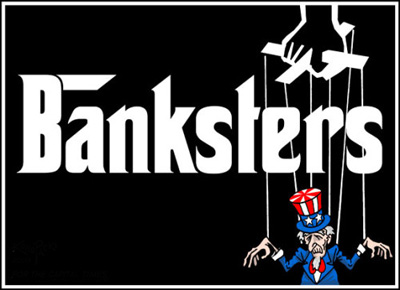 It was the best of times, it was the worst of times, it was the age of QE, it was the age of fiscal foolishness, it was the epoch of the Fed Put, it was the epoch of Greater Fool Theory, it was the season of golden light, and it was the season of fiat darkness. It was the best of times, it was the worst of times, it was the age of QE, it was the age of fiscal foolishness, it was the epoch of the Fed Put, it was the epoch of Greater Fool Theory, it was the season of golden light, and it was the season of fiat darkness.
My apologies to Charles Dickens.
IT’S ALL ABOUT LIQUIDITY. Central banks created currency units and levitated stock and bond markets since the financial crisis over a decade ago.
- Central bank balance sheets exceed $20 trillion. They created (from nothing) trillions of fiat dollars, euros, yen, Swiss francs, and pounds.
- Digital currency units purchased bonds which forced interest rates down to near zero. Trillions of dollars in sovereign debt “pay” negative interest. This is central bank nonsense.
- Other currency units purchased stocks and sent them skyward.
- Global debt increased to over $250 trillion, a stratospheric ascent.
- Fiscal and monetary sanity collapsed. Central banks pretend to have a plan but privately they buy gold.
- And now we have “not QE.”
The direct beneficiaries of QE, “not QE,” bond monetization, and massive debt creation are the financial markets, stocks and bonds. Those paper and debt-based assets are primarily owned by the upper 10% and particularly the upper 1%.
Central banks take care of their own.
The lower 90% accumulated debt—larger mortgages, student loans, car loans, and credit card debt. The upper 10% increased their net worth during the last ten years while the lower 90% fell deeper into debt.
From The World Bank on Debt:
“The size, speed, and breadth of the latest debt wave should concern us all.”
“History shows that large debt surges often coincide with financial crises in developing countries, at great cost to the population.”
THE TWO MARKETS – S&P 500 INDEX AND SILVER:
The S&P 500 Index represents large stocks that rallied based on QE, massive debt, stock buybacks, greed and monetary euphoria. Think paper assets.
Silver is a metal, a real asset, necessary for electronics, cruise missiles, solar panels and hundreds of other uses. Prior to the century long “age of paper,” when the U.S. descended into the deceit of central banking, silver had been money in hundreds of cultures for several thousand years.
Central bankers can’t “print” silver, but they can “print” digital currency units. Consequently, silver gets little respect and no support from the political and financial elite. Silver prices inevitably rise as governments and central banks devalue the dollar. They rise and fall with confidence in the financial economy, fear, investor desire for real assets, and mining supply.
Fifty years ago, silver prices (1969) were about $1.80. In late 2019 silver sells for less than $18.00, nearly ten times higher.
But the S&P 500 Index in 1969 was about 100 and today it exceeds 3,200, about 32 times higher. Central bank “printing” supports the S&P more than silver prices.
Examine the log-scale graph of the S&P for about 50 years. Note the exponential price rise, the bubble in year 2000, collapse in 2008-09, and the astounding (unsustainable) rise during the past decade.
In 2009 the S&P fell below 670. Today it is five times higher after a 28% rise in the past 12 months. On the monthly, weekly and daily charts (below) the S&P 500 Index is over-bought, too high and ready to fall. However, it has been over-bought before and rallied further. Central bank injected liquidity has amazing power to levitate stocks, despite weaker earnings, high P/E multiples, ugly news, excessive leverage, and circling “black swans.” It will fall, perhaps soon. The trend remains up, but is stretched thin.
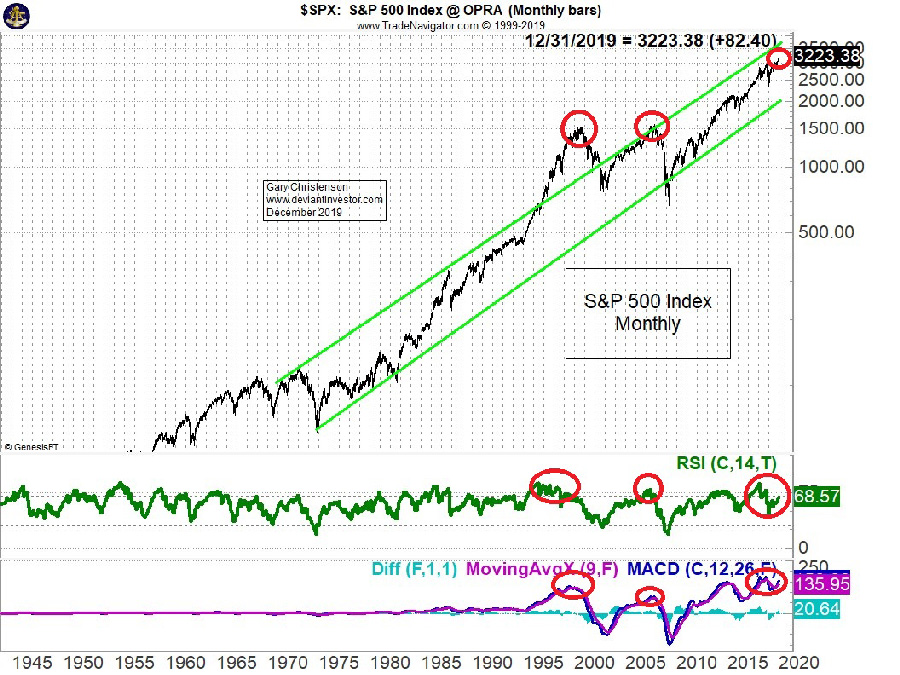
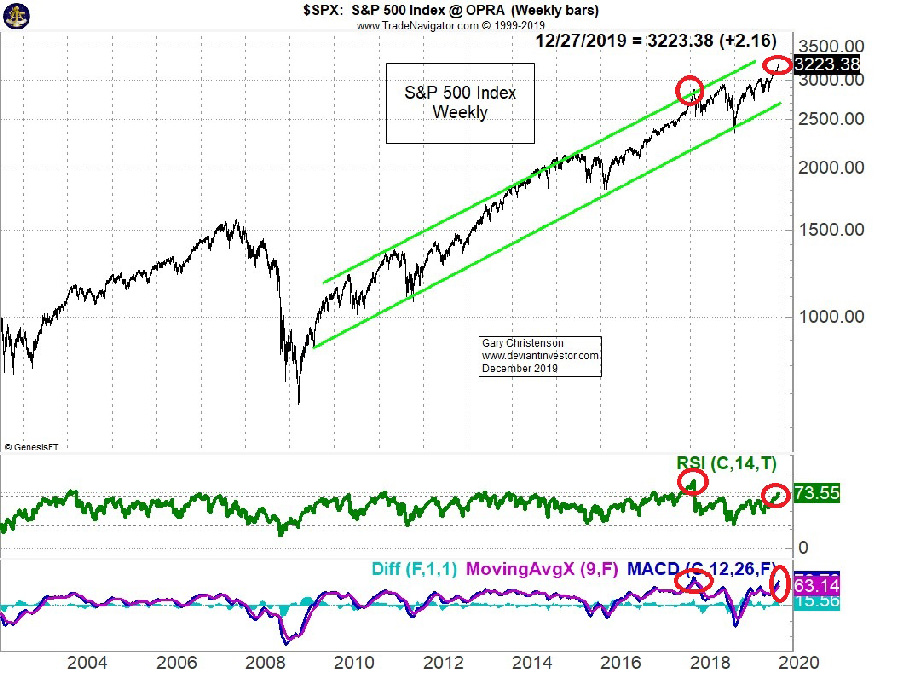
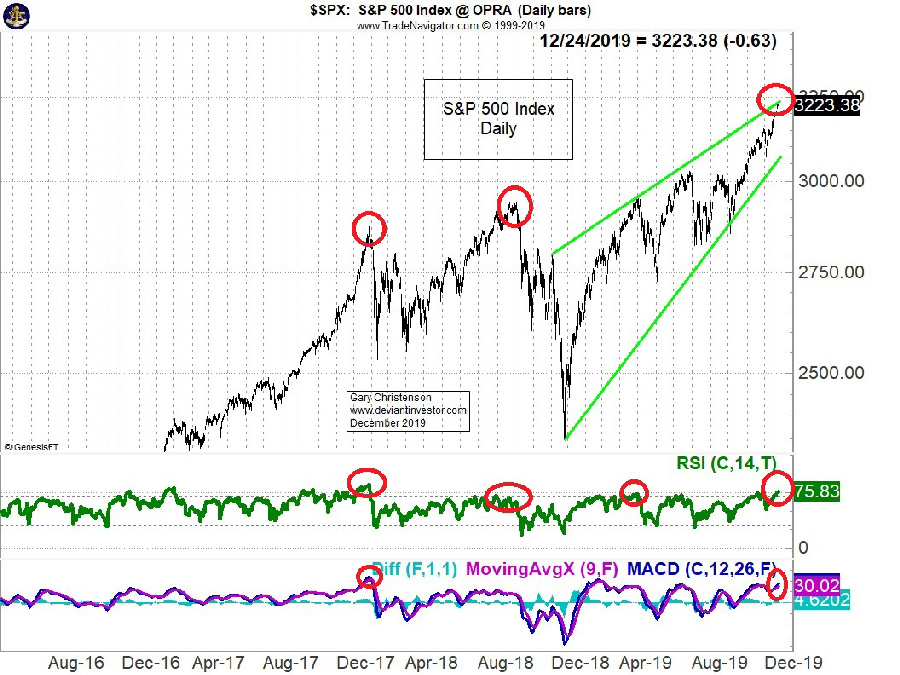
Silver peaked in April 2011, bottomed in December 2015, and has slowly risen off that low. Four lines on the silver graph show breakouts from down trending resistance lines. Prices rallied after each breakout, substantially after the 2001 and 2008 lows. Silver prices are far from over-bought on the daily, weekly and monthly charts. Many analysts see an aggressive price appreciation coming in 2020.
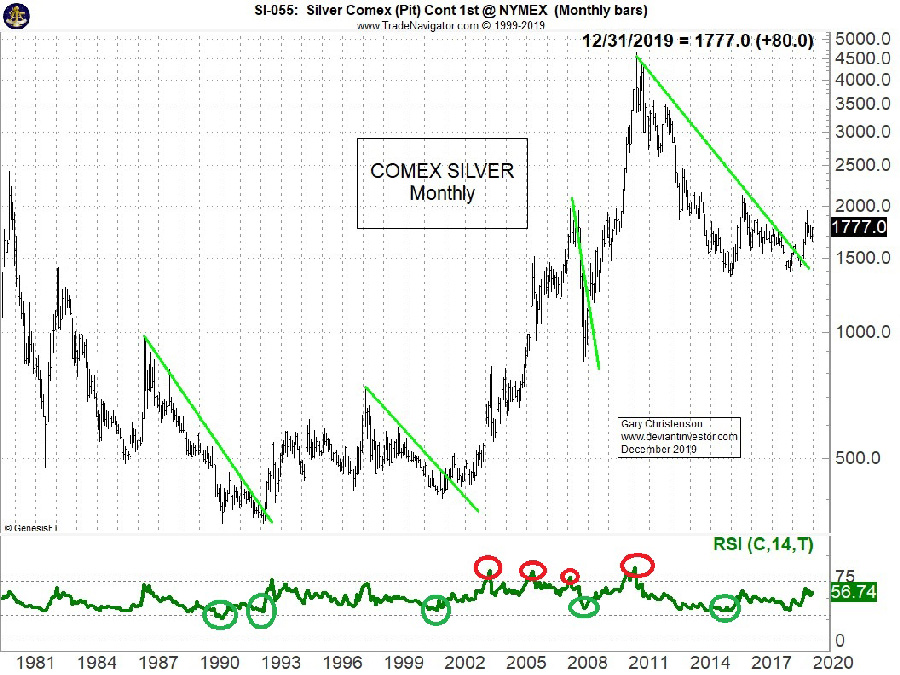
The silver to S&P 500 ratio shows that silver is inexpensive compared to the high-flying S&P. Imbalances always correct. This ratio shows that silver prices in late 2019 are almost as inexpensive, relative to the S&P, as they were in 2001, when they bottomed at $4.01.
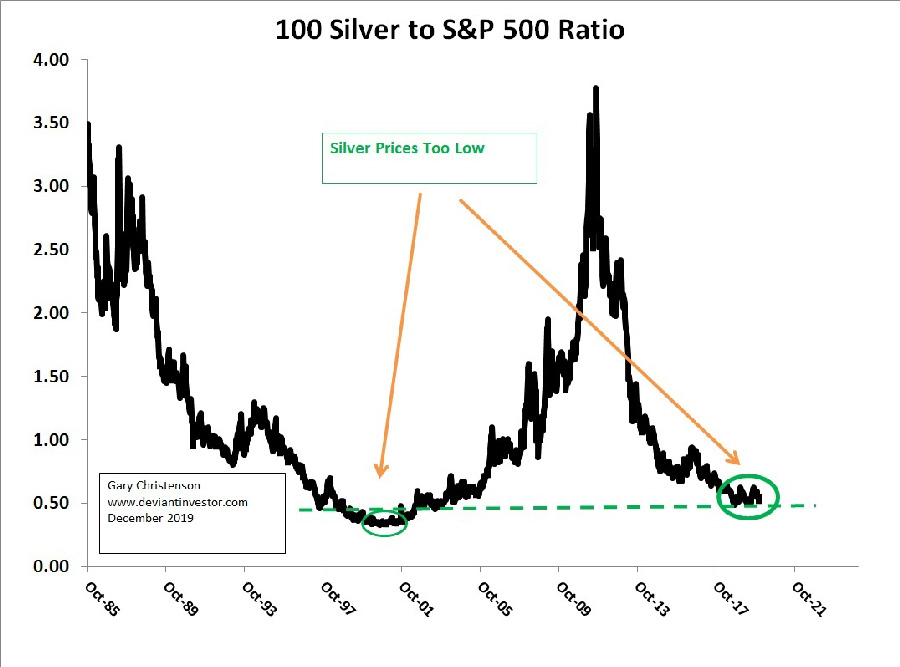
Will 2020 be the year for another huge rally? We wait to see, but consider possibilities:
- The impeachment circus distracts people from addressing the incredible and destructive debt the US government created. That debt will boost commodity prices, including silver and gold, perhaps soon.
- Prices have risen in financial assets for over 10 years. Commodities have languished. That ratio will reset higher.
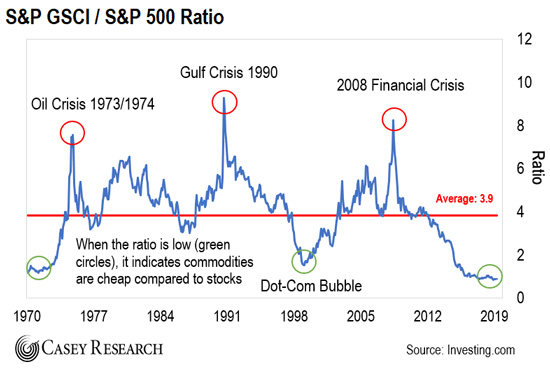
- If President Trump is NOT re-elected, we will see higher taxes, huge debt increases, QE4ever, MMT, expanded social programs, pension fund bailouts and excessive fiscal, monetary and political nonsense. Social, fiscal and monetary trauma will descend upon the US.
- If President Trump is re-elected, expect more of the same—much more debt, QE4ever, wars, bailouts, and fiscal and monetary nonsense. Social, fiscal and monetary trauma will descend upon the US.
- The US stock markets will crash/correct, probably soon.
- Can central banks hold interest rates low forever? They can’t, so expect a huge increase in corporate bankruptcies. Governments will monetize debt to continue spending. The Fed supports US government borrowing via QE and “not QE.”
- Silver and gold prices will rise due to consumer price inflation, fear of inflation, QE4ever, low interest rates, a weaker dollar, and expanded wars.
- Higher prices for silver and gold lie ahead. The path to higher prices is unclear, but there is little doubt that the Fed will devalue the dollar, debt will rise, the stock market will correct/crash, and fear will drive investors into silver.
- Central banks have bought gold since the financial crisis. They create currency units at no cost, but they buy gold. Watch what central banks do, not what their propaganda proclaims.
From Sven Henrich: Imbalance II (Read this!)
“A technical reversion of size will come. How deep, steep and fast this reversion will prove to be we will have to assess as it unfolds. But remember the market will seek balance technically. It did after last year’s imbalance to the downside, I expect the same coming from this year’s imbalance to the upside.”
CONCLUSIONS:
- The S&P is over-bought and ready to fall, perhaps hard. Silver prices have languished since April 2011, broke out in mid-2019 from an eight-year downtrend, and are in position for a rapid rise during 2020 – 2025.
- The downside risk for the S&P 500 is much larger than downside risk in silver. Upside potential in the S&P 500 is minimal, while silver’s potential is huge. Time will tell the strength of the reversal.
- During the past 50 years Fed liquidity injections have supported a rise in the S&P by a factor of 32. Silver has risen less than a factor of 10.
- Since the 2008-2009 bottoms, silver is up by a factor of 2, while the S&P is up by nearly a factor of 5.
- Don’t bet against the power of the Fed to levitate paper and debt markets. But don’t delude yourself into believing the Fed is powerful enough to boost the S&P forever. Bond yields will rise someday, perhaps violently. Silver prices will exceed all-time highs.
- In 2009 who believed the S&P would exceed 3,000 by 2019? It did. In 2019 who believes silver will pass $100 per ounce by 2029? It will.
Miles Franklin knows silver is money, markets rise and fall, and silver and gold are long-term protection for your savings and retirement funds. Call 1-800-822-8080 and convert dodgy debt-based fiat currency units into real money. By the time Mainstream Media proclaims the 2024 election is “the most important election ever,” the value of silver will be evident.
Gary Christenson
The Deviant Investor

Gary Christenson is the owner and writer for the popular and contrarian investment site Deviant Investor and the author of several books, including “Fort Knox Down!” and “Gold Value and Gold Prices 1971 – 2021.” He is a retired accountant and business manager with 30 years of experience studying markets, investing, and trading. He writes about investing, gold, silver, the economy, and central banking. His articles are published on Deviant Investor as well as other popular sites such as 321gold.com, peakprosperity.com, goldseek.com, dollarcollapse.com, brotherjohnf.com, and many others.
deviantinvestor.com
|




